Macclesfield Town
Organised football in Macclesfield can be traced back to 1873 when the 8th Cheshire Rifle Volunteers (Volunteer Rifle Regiments were a forerunner of the Territorial Army) adopted team games in addition to gymnastics and athletics. They played their first game against the FreeGrammar School on 29 March 1873, losing 0-3. In November of 1873 a second fixture against members of the Olympic Cricket Club was played ending 0-0. More games followed as new teams emerged in the town under various rules, usually agreed between the captains beforehand.
As the game grew in popularity the riflemen and cricketers decided to join forces and in October 1876 the Courier announced the formation of Macclesfield Football Club. One week later they played their first fixture against Stoke, at the time one of the strongest teams in the Midlands. A flexible attitude continued to be taken to the rules of the game at least until the team began to take part in proper competitive matches as opposed to friendlies.
Macclesfield was at the time the centre of silk production in the UK with 120 mills and dye houses so it was inevitable that the football team would become known as "The Silkmen."
By 1882 Macclesfield were the strongest team in the town and entered the FA Cup for the first time. When professionalism was recognised in 1885 Macclesfield took advantage of the new rules to consolidate and build up their team, winning the Cheshire Cup in 1890 and 1891, their first senior honours.
In 1890 Macclesfield joined the Combination League and a year later they moved into the Moss Rose Ground where the modern club still plays, leaving behind their notorious Victoria Road mud-bath pitch. In 1895 the club was in financial difficulties and a limited company was formed, raising £500 from issuing shares. It was not enough to keep the club solvent and in 1897, having finished bottom of the Combination, the club was wound up.
Moss Rose was promptly taken over by the amateur Hallefield FC, members of the Stockport & District League. Several amateur players and a number of officials from the defunct club now joined Hallefield who stepped up to the North Staffordshire & District League in 1898.
In 1899 they played as Hallefield-Macclesfield FC before becoming Macclesfield in 1900 and joining the Manchester League. In 1911 they moved up to the Lancashire Combination Second Division and won promotion to the First Division in 1914. When the FA announced that formal competition would be suspended at the end of the 1914-15 season, the club closed down. Macclesfield continued to exist on paper until March 1916 when it went into liquidation to pay off pre-war debts. The remaining assets, consisting of the grandstand, were bought by Councilor Walter Brown.
In August 1919 a new club was formed as Macclesfield FC and agreement reached with Cllr Brown to use Moss Road once again. They joined the Cheshire League where they had a modest career.
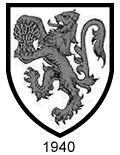 The club closed down for the duration of the Second World War after winning the Cheshire Senior Cup final in 1940, a match in which a crest was worn, perhaps for the first time.
The club closed down for the duration of the Second World War after winning the Cheshire Senior Cup final in 1940, a match in which a crest was worn, perhaps for the first time.
After a newspaper campaign to raise support, a new limited company was formed in April 1946. Deteriorating wooden supports on the main 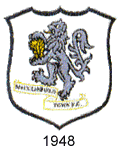 stand were replaced, the changing rooms rebuilt and, thanks to the donation of clothing coupons, playing kit (in royal blue and white) and boots were purchased. As a gesture towards the communal support received by the club, the new title of Macclesfield Town was adopted.
stand were replaced, the changing rooms rebuilt and, thanks to the donation of clothing coupons, playing kit (in royal blue and white) and boots were purchased. As a gesture towards the communal support received by the club, the new title of Macclesfield Town was adopted.
In 1948 a crest was adopted that bore a lion carrying a wheat sheaf taken from the coat of arms of the town.
It was not until the 1960s that "The Silkmen" began to make an impression outside of Cheshire, making three appearances in the FA Cup First Round. In 1968 they featured on Match of the Day when they were beaten by Fulham in the third round by 4-2, having led 2-1 at half time.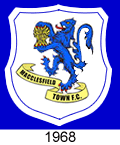 The following season Macclesfield became founder members of the Northern Premier League and clinched the title at the first attempt.
The following season Macclesfield became founder members of the Northern Premier League and clinched the title at the first attempt.
In 1970 they won the new FA Trophy at Wembley wearing a special all-blue outfit for the occasion.
The promise of these early successes soon faded, however, as financial problems forced the club to cut back on playing staff and by the end of the decade they were struggling to survive at the foot of the NPL. One of the more creative ways the club was kept going by the local business community was a sponsorship deal with Harry Kearn's FMK company under which Macclesfield played in FMK's corporate colours of tangerine and black in 1975-76.
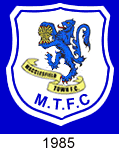 Their fortunes revived to some extent during the 1980s and in 1987 they won a treble of the Multipart Northern Premier League title, League Challenge Cup and President's Cup. More important, however, was that they were promoted to the GM Vauxhall Conference.
Their fortunes revived to some extent during the 1980s and in 1987 they won a treble of the Multipart Northern Premier League title, League Challenge Cup and President's Cup. More important, however, was that they were promoted to the GM Vauxhall Conference.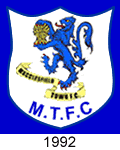 The lion and wheat sheaf crest became a permanent feature of the team's shirts during this period. The shield on the version worn from 1992 was modified slightly.
The lion and wheat sheaf crest became a permanent feature of the team's shirts during this period. The shield on the version worn from 1992 was modified slightly.
After seven seasons consolidating, Macclesfield won the Conference championship but were denied promotion to the Football League because their ground did not meet the required standard. The following season they won the FA Trophy for the second time and in 1997 they were Conference champions once again. Investment in safety improvements meant that this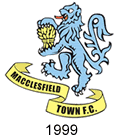 time promotion to the Football League was assured.
time promotion to the Football League was assured.
In their first ever season in the League, Macclesfield stormed to promotion as runners-up in Nationwide Division Three. It proved too much and they were relegated the following season.
In 1999 there was a slight change of image as the started to play in all-blue with an updated crest. The new strips were launched under the club's own brand, Silkman Leisure.
In December 2005 the FA ordered the club to pay a fine of £62,000 plus £195,000 in compensation to the Football Foundation due to irregularities in the financing of a stand built between 2000 and 2002. Macclesfield had always struggled to attract support because of their proximity to so many big-city clubs and were reportedly losing £25,000 each month.
had always struggled to attract support because of their proximity to so many big-city clubs and were reportedly losing £25,000 each month.
A new crest was supposed to have been introduced in 2007 but it attracted criticism from many supporters and was dropped until a more acceptable design was approved. This appeared in the 2008-09 season for the first time.
The club now took 1874 as the date of their formation although this is dubious as the original Macclesfield FC was not constituted until 1876. Furthermore, that club was wound up in 1897 and a quite different club, Hallefield FC then took up residence at Moss Rose before it too went out of business in 1916.
